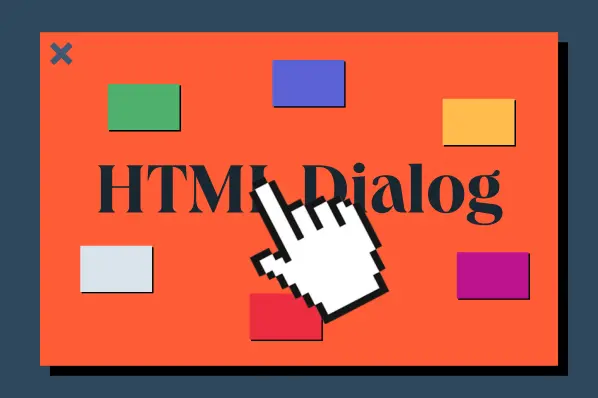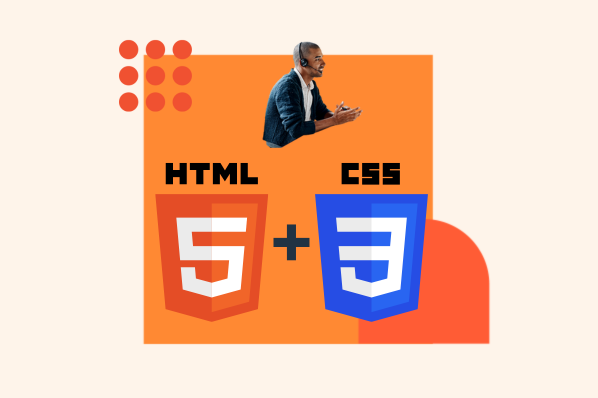HTML is the core language of the World Wide Web, so web development candidates must have a robust comprehension of it. When you ask HTML interview questions, you‘re looking for insight into how technically proficient the prospective employee is. To successfully do so, you’ll have to ask the right questions.
Reviewing popular HTML interview questions and the best answers is an excellent way to ensure you're fully prepared to speak with candidates. Or maybe, you're the one interviewing for a developer role instead — in which case, congratulations and best of luck!
Whether you hone in on HTML5 or the intricacies of attributes, understanding the best responses to these popular HTML interview questions will help streamline finding the right person for the role.
60 Best HTML Interview Questions and Answers
- What does the acronym HTML stand for?
- Describe HTML to us.
- Why do you use HTML tags?
- Do HTML tags require an end tag?
- What's the primary difference between elements and tags?
- What are some list types you may use when designing a page in HTML?
- Block-level elements vs. inline elements: what's the difference?
- Is it possible for a single text link to point toward two different website pages?
- Can you write the basic structure of the HTML template?
- What is an HTML attribute?
- Can attribute values get set to any number, or are there specific values they accept only?
- What is an HTML anchor tag, and why is it used?
- When are HTML comments used?
- If you want to display data in tabular form, which HTML tags would you use?
- How do you make an HTML hyperlink?
- How many ways could you specify CSS styles for an HTML element?
- Does a hyperlink apply to images, text, or both?
- What is a style sheet?
- What’s the difference between a logical and physical tag?
- How would you keep HTML list elements straightened out?
- What is the class attribute, and why is it used?
- What is an HTML layout structure? Explain it.
- Can all character entities be properly displayed on all systems?
- How can you optimize website assets loading with HTML?
- Why are meta tags useful in HTML?
- What is an Iframe?
- What are HTML forms? Why are they useful?
- How many types of headings are there in HTML?
- What is an HTML entity?
- What are the HTML formatting tags?
Basic HTML Interview Questions
If you’re interviewing for a web developer role, you’ll likely have to answer some of these questions. Your interviewer is using your answers to gauge your level of understanding regarding HTML.
1. What does the acronym HTML stand for?
The term HTML is short for Hypertext Markup Language. This language is widely used and, therefore, considered the primary language of the internet.
2. Describe HTML.
You can use HTML to create website pages or templates and present the content to the World Wide Web.
3. Why do you use HTML tags?
We use HTML tags to help format content correctly. Tags include using the greater than character > and the less than character <. A slash character is a closing tag. For instance:
4. Do HTML tags require an end tag?
No, not all HTML tags require an end tag.
5. What's the primary difference between elements and tags?
In HTML, tags mark the beginning or end of an element. However, an element holds the content and is the collection of the starting tag, attributes, everything in between, and the end tag.
6. What are some list types you may use when designing a page in HTML?
You can use several types of lists on a webpage. You'll use a tag set to create these. The types of lists include:
- A definition list.
- A menu list.
- An ordered list.
- An unordered list.
- A directory list.
7. Block-level Elements vs. Inline Elements: What's the difference?
Inline elements (such as <a>, <b>, <span>, <label>) take the width necessary to fill the container. In contrast, block elements (<p>, <section>, <img>, <div>) are blocks that take up the full available width. They'll always begin from a new line, too.
8. Is it possible for a single text link to point toward two different website pages?
Because the <a> tag can only accept one href attribute, this is not currently possible.
9. Can you write the basic structure of the HTML template?
Yes, here it is.
Intermediate HTML Interview Questions
10. What is an HTML attribute?
An HTML attribute is placed inside the opening tag and will adjust the element's behavior. They can also adjust the way an HTML element is displayed.
11. Can attribute values get set to any number, or are there specific values they accept?
It depends. While some attribute values can only be pre-defined, others can accept any numerical value so long as it represents the pixel count for a size.
12. What is an HTML anchor tag, and why is it used?
An HTML anchor tag <a> is implemented to link two sections, website templates, or web pages. It features an href attribute that works to create the hyperlink. The content within each anchor tag should indicate the link's destination.
13. When are HTML comments used?
In an HTML document, comments serve as helpful notes. These notes allow developers to mention modifications that need to be incorporated later. It‘s also important to remember that notes aren’t displayed in the browser when code is executed.
14. If you want to display data in tabular form, which HTML tags would you use?
To arrange data in tabular form, you’d use the following tags:
- <table> — To define a table.
- <tr> — To define a row in the table.
- <td> — To define a cell in the table.
- <caption> — To mention a caption to the table.
- <th> — To define a header cell in the table.
- <col> — To specify column properties for each column found in the table.
- <tbody> — To group the body’s content in the table.
15. How do you make an HTML hyperlink?
You'll start with the <a> tag to make a hyperlink. Then, you‘ll add the href attribute to indicate the link’s destination. The link text portion will be visible to the reader, and by clicking on the text, the reader will be able to reach the address. An example is: <a href=“https://hubspot.com/“>visit HubSpot!</a>
16. How many ways could you specify CSS styles for an HTML element?
There are three ways to specify CSS styles for HTML elements. These include internal, inline, and external.
17. Does a hyperlink apply to images, text, or both?
You can use a hyperlink on an image, text, or both.
18. What is a style sheet?
A style sheet is helpful for developers who want to craft transportable, consistent style templates. A developer can then add these templates to several web pages. The style sheet will describe the formatting and look of the document. It's in the markup language, which, in this case, is HTML.
19. What’s the difference between a logical and physical tag?
While both logical and physical tags can increase visibility and text understanding by the web page user, the physical tag decides the text’s appearance and doesn't provide any additional information. On the contrary, logical tags describe the nature of the content and its behavior for the text inside the tag.
20. How would you keep HTML list elements straight?
You can use indents to keep your list elements straight.
21. What is the class attribute, and why is it used?
Developers use the class attribute to specify the class name for an element. Remember that multiple HTML elements can have the same class value. It can associate styles described in the stylesheet with the appropriate HTML elements.
22. What is an HTML layout structure? Explain it.
While webpages vary greatly in their formats, most have several things in common. These are globally accepted ways to structure your web pages, and they include:
- <article> — An article is a set of information.
- <aside> — This is the sidebar content on a page.
- <section> — This is used inside of your article block and will define the page's basic structure.
- <header> — This is where starting information about the webpage is stored.
- <footer> — This tag represents the final section of the webpage.
- <nav> — This is the page’s navigation menu.
23. Can all character entities be properly displayed on all systems?
Not all operating systems can correctly display character entities. If a system does not support certain characters, it will show them as boxes instead.
24. How can you optimize website assets loading with HTML?
To optimize your website load time successfully, you'll need to optimize the asset loading. There are a few ways to do that.
- File compression. This will help you reduce the size of the asset and, therefore, reduce the data transfer necessary.
- Lazy loading. Rather than loading all assets simultaneously, non-crucial assets can be loaded as needed.
- Minify scripts. This will reduce the size of CSS and JS files.
- CDN hosting. This is a content delivery network that comprises servers distributed geographically to reduce latency.
- File concatenation. This can reduce the number of HTTP calls and, therefore, optimize loading.
- Parallel downloads. If you host assets in multiple subdomains, this could help bypass the download limit of six assets per domain.
25. Why are meta tags useful in HTML?
A developer would include meta tags to signal the page description, character set, keyword, template author, and beyond to the browser. Meta tags are also helpful for search engine optimization to translate page contents to the search engine.
26. What is an iframe?
An Iframe is helpful because you can use it to embed an additional document within the present HTML document. It is written as <iframe>.
27. What are HTML forms? Why are they useful?
You can use an HTML form to gather user inputs. It‘s relatively simple to make a form because HTML provides a tag (<form>) to create it. They’re helpful if you‘re looking to collect information from a user. In that case, you’d use the <input> tag and place it inside the form. Then, collected user data gets delivered to the server for processing.
Keep in mind that there are several input types, including number, password, checkbox, button, submit, and text. You can use these to gather information or even to send an email.
28. How many types of headings are there in HTML?
There are six heading types in HTML. Remember: a heading is a block-level element used to provide a specific topic or section with a header.
29. What is an HTML entity?
In HTML, character entities display reserved characters or invisible characters. Technically speaking, an entity is a piece of text or a “string” that starts with an ampersand and ends with a semicolon.
30. What are the HTML formatting tags?
There are several HTML formatting tags. These include:
- <i> — will make text italic.
- <b> — will make text bold.
- <big> — will make text larger by one unit.
- <small> — will make text smaller by one unit.
- <em> — will make the text italic and include added importance with semantics.
- <sup> — will make text superscript.
- <del> — will display struck-out text.
- <mark> — will highlight text.
- <sub> — will make text subscript.
- <strong> — will mark text as important.
- <ins> — will display as added text.
31. What is an image map, and why is it important?
An image map allows you to link disparate web pages with just one image. This is represented with the <map> tag.
32. What is the required attribute, and why is it helpful?
The required attribute can be used in HTML to make a form field mandatory.
Advanced HTML Interview Questions
33. What's the difference between HTML and XHTML?
HTML is an acronym for HyperText Markup Language. XHTML is an Extensible HyperText Markup Language. It's a stricter version of HTML that is more XML-based. However, both are markup languages and can be used to craft web pages and apps.
34. Define the SVG element.
The <SVG> element serves as a container for SVG graphics. It offers several methods for drawing text, graphic images, circles, boxes, and paths. You can write these images directly in the HTML.
35. How many kinds of Doctypes are available, and what are they?
There are three types of Doctypes. These include strict, frameset, and transitional.
36. Why are the <head> and <body> tags important with HTML?
These tags are significant because they provide intel on the document structure. There's only one <head> tag in the document, and it will be closed in the <html> tag. The <head> tag will also always come before the <body> tag. The <head> tag will also provide metadata about the webpage. Tags closed by the head tag will not display on the webpage.
On the contrary, the <body> element will define the document's body. It also should be closed in the <HTML> tag. Once again, there can only be one body tag per document.
37. What is a void element in HTML?
An HTML element that does not need to be closed or have a closing tag is also known as a void element. Think: <hr />, <br />.
38. What's the advantage associated with collapsing white space?
Because white spaces are blank sequences of space characters, HTML looks at them as a single space character. The browser collapses multiple spaces into one space, so you can indent lines of text and not have to worry about having various spaces, which enables your HTML code to be much more readable.
39. What is a marquee, and why is it used?
You‘d use the marquee tag (<marquee>) if you’re looking to define a scrolling text area in your HTML document. It will then move across the section of the webpage you've indicated in either a vertical or horizontal direction.
40. Which tags do you use to separate a section of text?
Three tags can separate a section of text. These are <br>, <p>, and <blockquote>.
41. In HTML, what's the difference between SPAN and DIV?
While SPAN and DIV are elements that group together parts of a web page that are related, they have different functions. While SPAN is for inline organization, DIV is for block-level organization and the styling of page elements.
42. What is cell spacing?
The cell spacing attribute specifies how significant the space between cells should be. The space is 2 pixels by default, but developers can opt to update that.
43. What is cell padding?
In HTML, cell padding refers to the space between cell content and edges. By default, padding is zero, but developers can add it.
44. What is the difference between a link tag and an anchor tag?
You would use the link tag (<link>) to define a link between an external resource and a document. These are not clickable. On the contrary, an anchor tag (<a>) makes a hyperlink to another web page or page section. They're clickable.
45. Can you include JavaScript in HTML? If so, how?
Yes, you can include JavaScript code when you're writing HTML. HTML offers a <script> tag, which you can use to run JavaScript code. The entire HTML page will then be more dynamic.
46. If you do not include any text in between tags, what will display?
When there’s no text in between tags, nothing is formatted. This means that no formatting will show up.
47. Why is HTML formatting useful?
Formatting text allows for a more accessible, streamlined look and feel. You can achieve this by using various tags to create text that's bold, underlined, or italicized.
Best HTML5 Interview Questions and Answers
If you’re interviewing candidates for a role that’s HTML5-based, reviewing these questions and answers will help set you up for success. Don’t forget to read through the traditional HTML questions, as it’s beneficial to ask some of those as well.
What are the new form input types in HTML5? What is the HTML5 Quirks mode?
What is canvas? How many tags are necessary to create a web page using HTML5? Why is the figure tag used in HTML5? Say you complete a calculation in HTML5. What tag do you use to represent its result? How many attributes does the tag mentioned above have? In HTML5, can section elements have an article element? How can you include video or audio on your page? What does the addition of web workers mean?
48. What's HTML5, and why is it valuable?
HTML5 is the new and improved version of HTML that debuted in 2014. The World Wide Web Consortium released it. There are several defining characteristics of HTML5 that make it so essential.
49. What were the primary goals of releasing HTML5?
HTML5 significantly improves several crucial aspects of HTML. Its primary goals include:
- To deliver a more rigid parsing standard to ensure consistent cross-browser behaviors.
- To simplify error handling.
- To provide exceptional backward compatibility with older documents.
- To offer enhanced semantic support for web page structure by introducing new structural element tags.
50. Identify a few key features of HTML5.
HTML5 offers more robust capabilities than traditional HTML. Some of these include the introduction of both audio and video, header and footer, vector graphics, expanded input tags, placeholders, figure/figcaption, display control, adaptability, regular expressions, inline elements, additional support for dynamic pages, using email as a property, canvas, and more.
51. What are the new form input types in HTML5?
HTML5 introduced date, time, week, month, email, URL, range, search, color, number, tel, and DateTime-local.
52. What is the HTML5 Quirks mode?
Quirks mode is what happens if the <!DOCTYPE> element is not featured on the document/HTML page. The HTML element will depend on the browser when this occurs. Consequently, so will its display.
53. What is canvas, and why is it used?
Canvas refers to pixel-based graphics. It‘s one of the most important new features added by the implementation of HTML5. It works by allowing a space in the document where graphics are crafted using JavaScript. It’s also essential to note Canvas is resolution-dependent, so resizing impacts the quality.
54. How many tags are necessary to create a web page using HTML5?
There’s a minimum of three tags needed to create a webpage in HTML5. These include <body>, <head>, and <html>.
55. Why is the figure tag used in HTML5?
In HTML5, the <figure> tag will be used to specify self-contained content in an HTML5 page. (Think: photos and diagrams.) The content of the figure element is connected to the main flow of the document, but the position is independent of the same. So, if you remove it, you won't impact the flow.
56. Say you complete a calculation in HTML5. What tag do you use to represent its result?
If you're looking to represent a calculation result, you will use the <output> tag.
57. How many attributes does the tag mentioned above have? What are they?
The <output> tag features three attributes. These include form (to represent the form that the output element is associated with), name (to represent the output element's name), and for (to describe the relationship connecting the elements used in your calculation and its result).
58. In HTML5, can section elements have an article element? What about an article element having section elements?
In HTML5, it is possible for a <section> element to include <article> elements. It’s also possible for an <article> element to have one or more <section> elements.
59. In HTML5, how can you include video or audio on your page?
HTML5 offers two tags that help include video and audio into your webpage. These tags are <audio> and <video>.
60. What does the addition of web workers mean?
The term ‘Web workers’ is an HTML5-era addition. Adding it brings a multithreading capability to JavaScript. These scripts run in the background, so they don't require the page to wait for their completion.
Hire the Best Candidate with HTML Interview Questions and Answers
Preparing for a job interview is no easy feat — for the prospective employee or the company. However, asking the right questions will ensure that you’re hiring a qualified candidate. These questions will help decipher if a potential team member has the technical skills necessary to succeed in your open web developer role.
![Streamline Your Coding: 25 HTML & CSS Hacks [Free Guide]](https://no-cache.hubspot.com/cta/default/53/848be230-f06a-420e-9a24-82b45fe61632.png)

![Onchange Event in HTML: How to Use It [+Examples]](https://blog.hubspot.com/hubfs/onchange.webp)




![How to Embed Google Map in HTML [Step-By-Step Guide]](https://blog.hubspot.com/hubfs/Google%20Drive%20Integration/How%20to%20Embed%20Google%20Map%20in%20HTML%20%5BStep-By-Step%20Guide%5D-2.jpeg)

![How to Create an HTML Tooltip [+ Code Templates]](https://blog.hubspot.com/hubfs/Google%20Drive%20Integration/How%20to%20Create%20an%20HTML%20Tooltip%20%5B+%20Code%20Templates%5D.jpeg)
![How to Make an HTML Text Box [Examples]](https://blog.hubspot.com/hubfs/html%20text%20box.jpg)